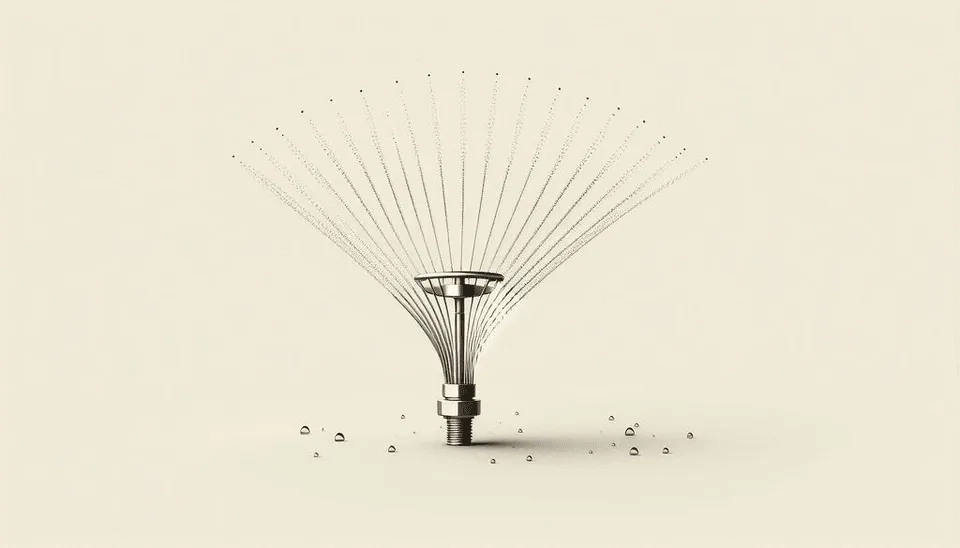
These days, enhancing yield and water efficiency are two of the modern agriculture aims. Various irrigation methods have been implemented, such as pre-sowing irrigation, supplemental irrigation, and sprinkler irrigation. Among these, sprinkler irrigation integrated with water fertilizer technology has demonstrated the most promise, offering benefits such as uniform water and nitrogen use efficiency trigger sprinkler irrigation compared to traditional methods. (yao et al, 2023)
Sprinkler irrigation systems have demonstrated higher-level performance in several main areas compared to traditional surface irrigation methods. Researchers consistently highlight the enhanced irrigation efficiency, water use efficiency, and eventually, improved economic returns achieved because of applying sprinkler irrigation in crop production. By delivering water directly to the plants, sprinkler systems diminish water loss due to runoff and deep percolation, ensuring that more water reaches the root zone where it can be effectively available for use by the crops. As you know, optimized water delivery translates to increased yields and enhanced crop quality, leading to better profitability for farmers. However , applying this technological advancement comes at a cost. Sprinkler systems typically need noticeable energy input to run, particularly when compared to surface irrigation methods with similar water resource conditions. This increased energy consumption has a significant impact on the overall operational costs of sprinkler irrigation, potentially balancing out some of the economic gains achieved through enhanced efficiency (Pair, 1969; Evans et al., 2013).
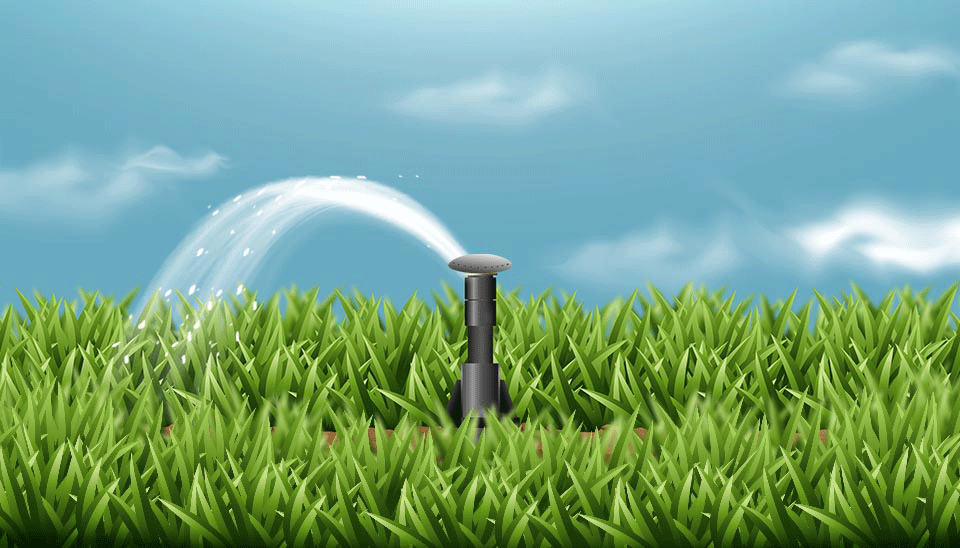
In this article, we aim to explore five practical methods to enhance uniformity and water use efficiency in sprinkler irrigation systems. These methods include the implementation of smart controllers, leaching control, appropriate nozzle selection and placement, regular system maintenance, and the use of windbreaks. By examining these strategies, we aim to provide insights into optimizing sprinkler irrigation for sustainable agriculture and water conservation.
1. Smart Controller
As you know, irrigation is an important part of agriculture to save crops, especially in regions facing water shortages and with unsustainable water resources. Traditional irrigation methods are still being used in many regions, but with the knowledge of the advantages of modern irrigation techniques, many farmers are shifting towards modern irrigation systems with higher productivity, like drip and sprinkler systems that have significant enhancements in crop productivity and water use efficiency. According to many studies, drip irrigation implements are useful in arid and semi-arid regions because of their impact on water savings. Nowadays, sprinkler systems are widely used in horticulture for their ease of implementation and water-saving. (Bhavsar et al, 2023)
In an automatic irrigation system, hire valves with remote control to turn on or off the pump in an irrigation control system that uses Android and GSM mobile applications to enhance efficient use of water and power. By implementing this technique, farmers could enhance crop production by ensuring sufficient water and nutrients that plants need in their growing period and they could avoid excessive irrigation and irrigation at the wrong time.
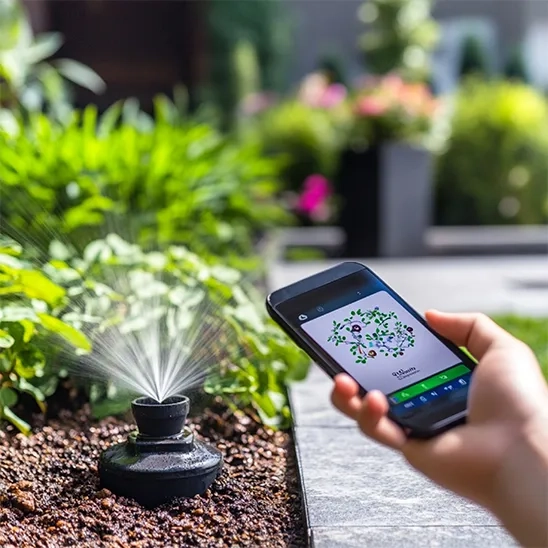
moisture balance combined with capacitance techniques, heat flux soil moisture sensors, micro-electro-mechanical systems, and optical techniques can be used in conjunction with irrigation management. Modern irrigation systems could provide site-specific and time-specific irrigation controls, applying these techniques to increase the efficiency of irrigation. (Bhavsar et al., 2023).
Smart irrigation uses connected sensors, gadgets, and remote controllers to water fields in a modern method.
Weather conditions and farm soil moisture sensors are two main types of smart irrigation controllers. You can use a determined geographic location and surrounding terrain as a good option. Evapotranspiration (ET) controllers are based on climate and a suitable alternative for irrigation schedules in response to local meteorological information. Evapotranspiration considered both soil surface evaporation and plant component transpiration.
Soil moisture sensors shouldn't be implanted near sprinkler heads, tree roots, walkways, and walls, and they must be representative of the section of the farm. Also, soil moisture sensors can attach to an irrigation system that is used.
Smart irrigation technology could reduce water wastage while providing a suitable and healthy environment.

2. Leaching Control
According to several studies, increasing fertilizer accumulated in soil when we use the sprinkler irrigation method is from top to deep, which means there is little leaching in this irrigation method. A study determining soil properties after use of sprinkler irrigation demonstrated noticeable increasing soil nitrogen content in the surface layer while lower soil nitrogen content in deeper soil layers. Also, it has been shown that nitrogen application efficient growth in the sprinkler irrigation method. Irrigation is a key factor affecting crop water productivity and water use efficiency, and improving these parameters can improve fertilizing. Eventually, optimization of irrigation management can further improve the water-saving potential and fertilizer management. (yao et al, 2023).

Fertilization use in farming, particularly nitrogen, can provide groundwater nitrate pollution and also greenhouse gas emissions. This study found that a base fertilizer to topdressing is a way for leaching control that can minimize nitrate leaching into deep soil, reducing the risk of groundwater contamination from fertilization. This optimized application not only reduces environmental harm but also enhances resource use efficiency by constant subsequent crops to absorb residual nitrogen from the surface soil, making this method a more sustainable and economically viable choice for winter wheat production (yao et al, 2023).
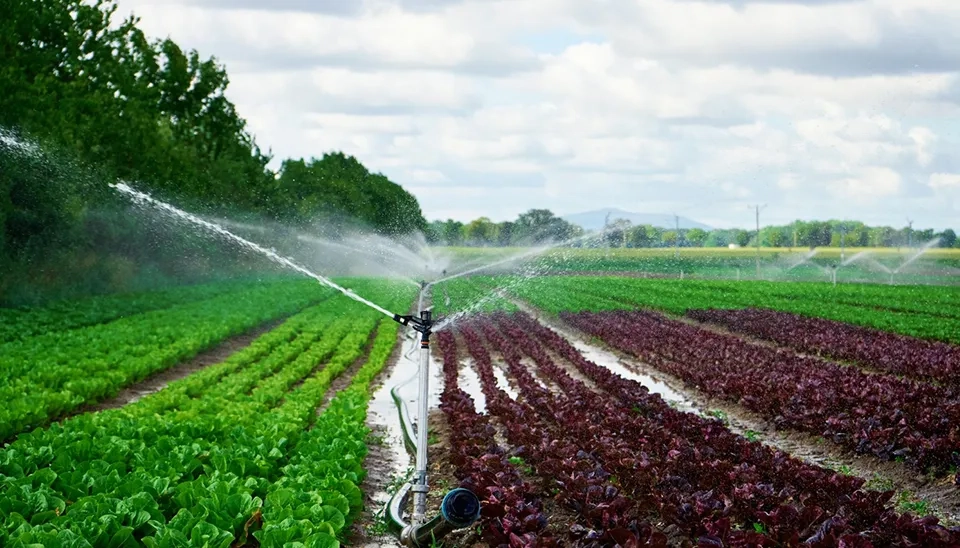
3. Appropriate Nozzle Selection and Placement
Studies show pressure and nozzle spacing impact spray distribution quality for crop conservation. According to results, increasing pressure particularly enhances distribution. Also, the nozzle model considerably influenced distribution quality and uniformity. The uniformity of spray distribution is a key point for enhancing crop protection. Disuniformity spraying triggers incorrect implementation rates and makes inappropriate coverage in some parts of the farm and consequently extreme spraying in others. It can exclude control of pests or disease and also diminish the effect of crop protection products.
Uniformity in the sprinkler irrigation system depends on some factors, including working pressure, nozzle model, spray angle, nozzle spacing, and distance from the target. Covering spray jets is necessary to gain uniform coverage in whole farmlands. Another key parameter that affects distribution quality is jet symmetry, angle, nozzle spacing, and boom height. Working pressure has considerable impacts on crucial application parameters like jet opening angle, spray flow rate, and droplet size. Applying pressure below manufacturer recommendations can compromise jet opening and have a bad effect on distribution quality; also, high pressure speeds up nozzle wear, accordance droplet quality, and bad impact distribution.
Working pressure noticeable impacts volumetric distribution; according to investigation of several nozzles, 300 kPa generally yielding the best results; however, 100 kPa was unsuitable for all nozzles examined. Definitely, nozzle model variations influenced distribution, and each model responded differently to pressure change (Griesang et al., 2022).
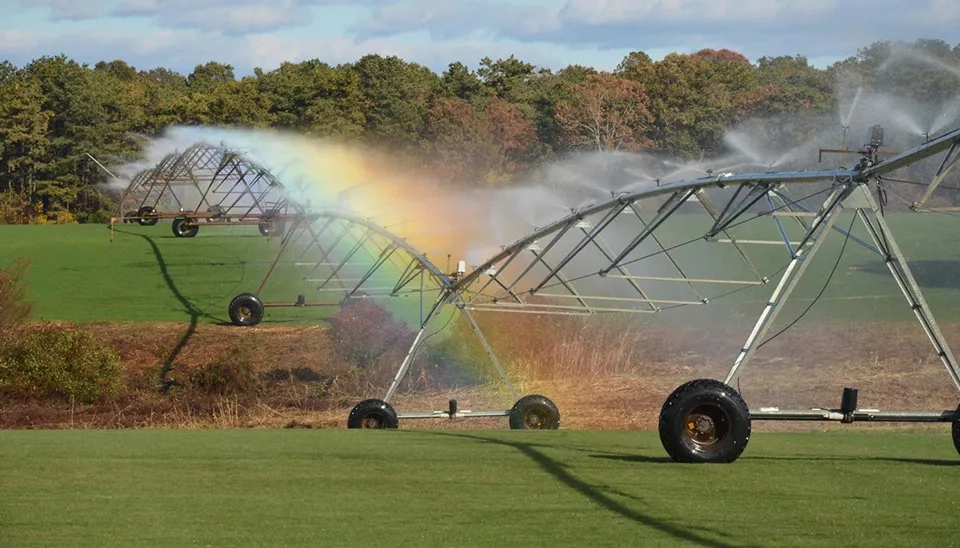
4. Regular System Maintenance
Irrigation is a way to supply plants with the water they need in agriculture that is crucial in climates with insufficient rainfall and shortages of water resources. People should use new methods of irrigation, such as pipelines and sprinklers, to improve productivity and also improve water use efficiency and eventually reach sustainable methods to face drought. Without regular maintenance, you could waste water in the running irrigation system too long or in case it operated incorrectly, so to reach optimum productivity, regular maintenance is necessary and unavoidable. Regular system maintenance has several basic parts that are as follows (Chaube et al., 2023; Rust et al., 2003; Team et al., 1997; Robles et al., 2019):
4.1. Test and Repair
The irrigation system should be periodically tested to make sure it’s operating correctly. Users should have scheduled that accurate time of the control system in different seasons of the year according to irrigation system use. In each control shift, all the sprinkler heads should be checked. Any clog, broken or missing nozzles can cause non-uniformity and dry spots in the landscape. Also, leaking lines must be repaired and inappropriate nozzles with warped spray patterns should be replaced with new ones .

4.2. Adjust Heads
Nozzle heads could be moved in the trigger of humans or instrument accidents and broke system uniformity. You should adjust the nozzle head to irrigate only the landscape you want and avoid irrigating streets or sidewalks. Check nozzle angles to be in the right soil surface and prevent extra or low irrigation in some special part of the landscape. If sprinkler heads are downer, then the surface should pop up head above the surface .

4.3. Set Controller
Set a controller in your irrigation system. As you know, every plant has different water needs, and applying adequate water to the plant is the main key. Also, you should consider that plant water needs are different in each season according to weather and climate conditions. By setting controllers, waste water diminishes and use of the system is at optimum. Explanation of smart control given above .

4.4. Calibrate
It’s necessary to calibrate the nozzle to determine how much water the system is applying. By this determination, we can prevent over- or under-watering our plants that could be harmful for them. Calibration is an easy process that everybody can do themselves. Steps of initial calibration given in follows:
Gather five to ten straight side containers that are 3 to 6 inches in diameter for work best.
In the ground sprinkler irrigation system , you can place containers randomly throughout one zone at a time or for other sprinkler irrigation systems, place them in line or square patterns.
Let the system work for at least 15 minutes to spray water and then collect the containers.
You can use a ruler to measure the depth of water and eventually the volume of water in each container.
Calculate the volume of water and determinant average of containers.
Now to determine the irrigation rate, divide minutes of run time by 60 To convert minutes to hours and finally determine the spray water amount in inches per hour .
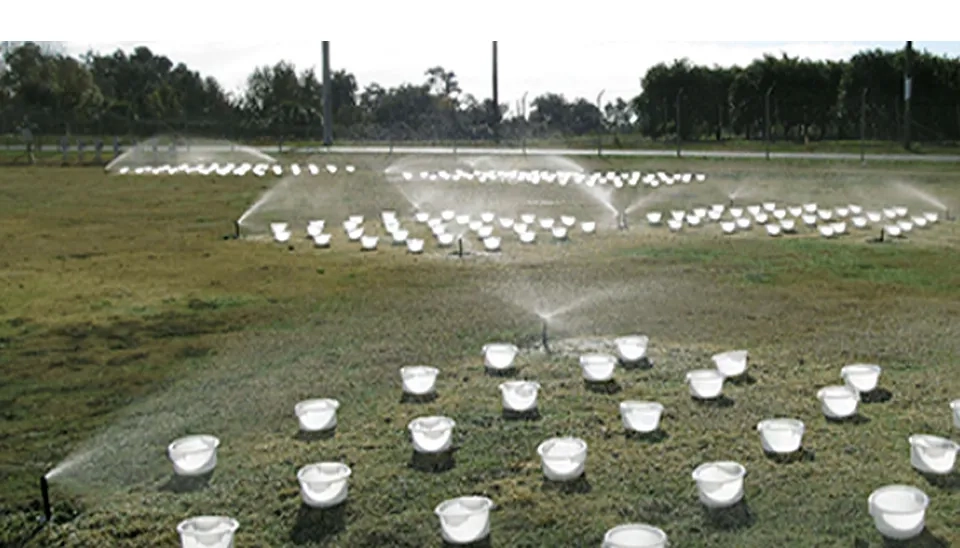
5. wind break
As we know, wind speed significantly influences the distribution uniformity of sprinklers. One of the initial ways to decrease evapotranspiration is to control or diminish wind speed. In dry climates, wind causes dry air to replace moist air. As you know, wind speed is an important factor on the field, and in windy areas, by decreasing wind speed with windbreak, you can reach lower crop evapotranspiration and also water requirements. If we can reduce the water requirement in irrigation, the energy use for pumping and applying the system will decrease, and consequently, the energy cost will be down. According to several studies, a windbreak could enhance water efficiency in spry by at least 10 percent and it also improves crop yield (Awwad et al., 2017)

In a study casuarin trees as windbreaks, where the height was 5.5 meters and the distance between the trees was 1.25 meters. The distance between the windbreak line and the land farmed was 7 meters. Accordingly, an increase in wind speed and temperature caused an increase in evaporation loss and it was a corresponding increase in evapotranspiration. Yield enhanced with windbreak productions were higher than those obtained in the zone without the windbreaks by 23 to 30 percent (Awwad et al, 2017)
According to Kilaka research, increasing wind speed due to the removal of windbreaks causes increasing evapotranspiration in irrigation agriculture, with water requirements up to 14 percent in windbreaks with a 2 meter height. In the absence of windbreaks, irrigation water up to 38% to 64% in different nozzles. Consequently, you can reduce the water requirements by using windbreaks that can reduce pumping, fuel and labour costs. Lastly, facing climate changes that trigger restricted water resources and increase temperature, windbreak can help mitigate water losses. (Kilaka et al, 2015).

In addition, windbreaks enhance coefficient uniformity in contrast to the absence of windbreaks. In general, windbreaks improve distribution uniformity in contrast to without windbreaks. Irrigation water use decreases and so water use efficiency significantly grows in farms with windbreaks. Also, the yield of peanuts has significantly improved in the presence of windbreaks (Awwad et al., 2017).
Conclusion
The sprinkler irrigation method is one of the novel irrigation methods that is applied in many regions and crops. Considering that implementations of this method are growing all around the world, users, as farms or domestics of this method, should know how to use it in an optimized way. Here we show 5 ways for improving uniformity and water use efficiency in this irrigation technique. With installing smart controllers, you know how much and when you should irrigate and prevent excessive irrigation while reducing water consumption. Leaching control is a method to reduce fertilizin use and also diminish water consumption by avoiding leach water and fertilizing. Appropriate nozzle selection and placement are keys to reaching uniformity of spray distribution for enhancing crop. On the other hand, regular system maintenance prevents waste water in various parts of the irrigation system and we can exactly divert water where we want and how much it needs. Eventually, installing windbreaks significantly increases the distribution uniformity of sprinklers. To sum up, applying these 5 ways can significantly improve uniformity and water use efficiency in a sprinkler irrigation system.